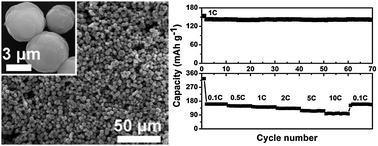Acid-assisted synthesis of dandelion-like rutile TiO2 and Li4Ti5O12 mesoporous spheres: towards an efficient lithium battery application
Abstract
In this study, a new acid-assisted

* Corresponding authors
a
Institute of Chemical Power Sources, Soochow University, Suzhou 215006, P. R. China
E-mail:
jwzheng@suda.edu.cn
b
Institute of Functional Nano & Soft Materials (FUNSOM) and Jiangsu Key Laboratory for Carbon Based Functional Materials & Devices, Soochow University, Suzhou, Jiangsu 215123, People’s Republic of China
E-mail:
zhkang@suda.edu.cn
c Key Laboratory of Chemical Biology and Traditional Chinese Medicine Research (Ministry of Education of China), College of Chemistry and Chemical Engineering, Hunan Normal University, Changsha 410081, P. R. China
In this study, a new acid-assisted

 Please wait while we load your content...
Something went wrong. Try again?
Please wait while we load your content...
Something went wrong. Try again?
H. Ming, X. Li, Q. Zhou, M. Liu, L. Su, L. Bu, Z. Kang and J. Zheng, New J. Chem., 2013, 37, 1912 DOI: 10.1039/C3NJ41144C
To request permission to reproduce material from this article, please go to the Copyright Clearance Center request page.
If you are an author contributing to an RSC publication, you do not need to request permission provided correct acknowledgement is given.
If you are the author of this article, you do not need to request permission to reproduce figures and diagrams provided correct acknowledgement is given. If you want to reproduce the whole article in a third-party publication (excluding your thesis/dissertation for which permission is not required) please go to the Copyright Clearance Center request page.
Read more about how to correctly acknowledge RSC content.
 Fetching data from CrossRef.
Fetching data from CrossRef.
This may take some time to load.
Loading related content
